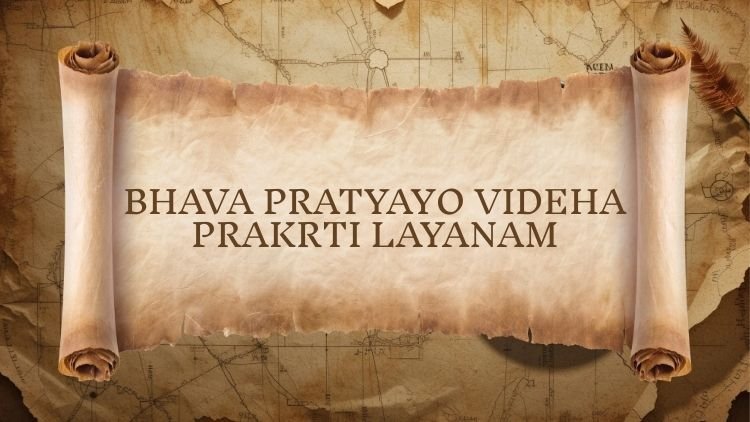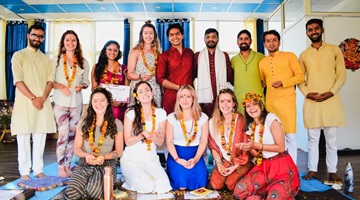Yoga Sutra 1.19: Bhava Pratyayo Videha Prakrti Layanam

As we journey deeper into Patanjali’s Yoga Sutras, the nature of meditation, inner insight, and transformation becomes more subtle and profound. In the previous sutras (1.17 and 1.18), two fundamental states of samādhi were introduced:
-
Samprajnata Samadhi — absorption accompanied by reasoning, reflection, bliss, and a sense of individuality.
-
Asamprajnata Samadhi — the stilling of mental fluctuations where only latent impressions remain.
In Yoga Sutra 1.19, Bhava pratyayo videha prakrti layanam, Patanjali describes another route to higher awareness. This path does not arise from steady discipline and practice, but from innate tendencies or karmic impressions carried over from past experiences. He explains that there are beings — either disembodied (videha) or merged back into nature (prakrti laya) — who appear to attain yogic states effortlessly. Yet, their liberation is not the same as the one achieved through conscious, sustained practice.
This sutra serves as a reminder: the yogic journey is not merely about rare mystical experiences or unusual states of existence. True and lasting transformation blossoms through dedicated, conscious practice — the path that remains accessible and reliable for all sincere seekers
What Does Yoga Sutra 1.19 Mean?
Yoga Sutra 1.19 states:
“For one born with exceptional tendencies (bhava-pratyayo), such as beings who are disembodied (videha) or merged in material nature (prakrti laya), a form of samādhi may arise naturally.”
At first glance, this sounds inspiring — the idea that some may be born with an innate capacity for meditative absorption or may enter it by merging with nature itself. Yet, Patanjali shares this sutra not to glorify such states, but to highlight their limitations.
These forms of samadhi are not the same as the enduring freedom of kaivalya (liberation). They stem from past karmic impressions, not from the clear, conscious realization of the Self in the present.
Thus, Sutra 1.19 teaches us two important truths:
-
Yes, natural states of absorption exist — some beings may seem to enter them effortlessly.
-
But they are not the final goal — true liberation requires consistent, conscious practice rather than relying solely on inherited tendencies.
Translation
Sanskrit
भवप्रत्ययो विदेहप्रकृतिलयानाम् ॥१९॥
Transliteration
bhava pratyayo videha prakrti layanam ॥19॥
Meaning
This sutra refers to those whose absorption (samādhi) arises from natural tendencies (bhava-pratyaya) rather than deliberate practice. Such beings are described as:
- Videha — subtle entities or advanced souls existing beyond the realm of the physical body.
- Prakrti laya — those who have dissolved back into nature, merging with its essence.
Word-by-Word Interpretation
- Bhava — natural disposition, state of being, or innate tendency.
- Pratyaya — cause, foundation, or perception that leads to a state.
- Videha — disembodied beings without a gross physical form.
- Prakrti — nature, the primal force of creation.
- Laya — dissolution, absorption, or merging.
- Anam — referring to “those” or “among them.”
Detailed Breakdown of the Sutra
1. Bhava-pratyaya — Born with Tendencies
Bhava-pratyaya refers to a state that arises naturally from one’s inherent disposition or essence. A few rare individuals are born with a deep inclination toward meditation, much like others may be born with an extraordinary gift for music, art, or intellect. These tendencies are often the result of strong samskaras (impressions) carried over from previous lifetimes of spiritual practice.
While this may appear to be a blessing, Patañjali reminds us that it is not the same as conscious, deliberate cultivation. Just as natural talent without practice can fade or remain underdeveloped, so too can these innate spiritual inclinations lose their power if not supported by sustained awareness, discipline, and effort.
2. Videha — Disembodied Beings
The term videha literally means “without a body.” In yogic philosophy, it refers to:
-
Elevated souls who no longer require a physical form, yet still carry subtle impressions (saṁskāras).
-
Beings dwelling in subtle realms — such as astral or celestial planes — who may enter states of absorption but remain bound by karma.
For such beings, samādhi arises more easily because they are free from the distractions of the physical body. However, this absence of distraction is not the same as true liberation. Without Self-realization, even these profound states remain temporary and incomplete.
3. Prakṛti-laya — Melted into Nature
Prakrti-laya refers to those who dissolve into the field of prakṛti — the fundamental elements of nature: earth, water, fire, air, ether, as well as mind, intellect, and ego. Such individuals merge into subtle matter and may experience a deep sense of peace and stillness.
However, this state remains within the domain of nature itself. While calming, it does not lead to the ultimate transcendence of puruṣa (pure consciousness). True liberation lies beyond the material realm, in realizing the Self that is untouched by prakrti.
4. The Key Distinction
Patañjali emphasizes that both videha and prakṛti-laya represent states of being, not conscious realizations of the Self. They may resemble samādhi in their depth and stillness, but they lack the clear light of true Self-knowledge. For this reason, these states cannot be equated with kaivalya — the complete and irreversible liberation that comes only through conscious realization.
Practical Reflections
1. Innate Talents vs. Practice
Just as natural musical ability cannot replace years of dedicated training, being “born meditative” is no substitute for disciplined effort. Yoga is not something inherited — it must be lived, practiced, and embodied.
2. Avoiding Fascination with Powers or States
Many seekers become intrigued by mystical experiences — formless absorption, merging into nature, or even reports of supernatural states. Yet, Patañjali gently reminds us that such fascinations can distract from the true goal. What matters is not the pursuit of extraordinary states, but the steady path toward lasting freedom and clarity.
3. The Value of Conscious Realization
The heart of this sutra lies in the reminder that liberation does not occur by default, nor through temporary entry into subtle realms. True freedom arises only through conscious realization of puruṣa — pure awareness beyond all fluctuation and form.
Comparison with Sutras 1.17 and 1.18
-
Sutra 1.17 describes samprajnata samadhi — a state attained through deliberate meditation supported by thought, reflection, and joy. This is a path of intentional and conscious effort.
-
Sutra 1.18 introduces asamprajnata samadhi, where even these supports dissolve, leaving only subtle impressions in the background. This is still a conscious state, but one that transcends active thought.
-
Sutra 1.19 shifts the focus to states that arise not through practice, but through natural circumstances — as in the cases of videha (disembodied beings) or prakṛti-laya (those merged in nature). While profound, these states remain incomplete without Self-realization.
Through these distinctions, Patañjali makes a crucial point: the highest path is not to rely on what is inherited or circumstantial, but to cultivate states of awareness through conscious, dedicated practice. It is the practiced yogi — not merely the naturally inclined one — who moves steadily toward liberation.
Applications in Modern Practice
1. Do Not Compare
Some people naturally appear serene, detached, or meditative. But your journey is uniquely your own. Comparing yourself to them only creates discouragement. Instead, honor your path and stay committed to your personal growth.
2. Appreciate the Value of Effort
Realization that comes through steady effort has a lasting strength that accidental or conditioned states can never provide. This is why Patañjali continually emphasizes abhyāsa (consistent practice) and vairāgya (detachment). Together, they form the foundation for true stability.
3. Root Your Path in Awareness
Modern life offers countless ways to “dissolve” temporarily — through distractions, entertainment, or even artificially altered states of consciousness. Yet these are fleeting escapes, not true freedom. Yoga calls us to return, again and again, to the living practice of awareness. Liberation arises only when awareness becomes our chosen ground.
Conclusion
Yoga Sutra 1.19 reminds us that the yogic path is not about extraordinary states or exceptional beings. Even the videha (disembodied) and prakṛti-laya (those merged with nature) are not liberated without true Self-realization.
Authentic freedom is found only through conscious practice, steady awareness, and the direct experience of puruṣa (pure consciousness). This sutra serves as a gentle warning — do not mistake temporary states or inherited tendencies for the ultimate goal of yoga.
Patañjali’s message is clear: the path of abhyāsa (consistent practice) and vairāgya (detachment) is the only sure road toward kaivalya — complete and unshakable liberation.
What's Your Reaction?


























